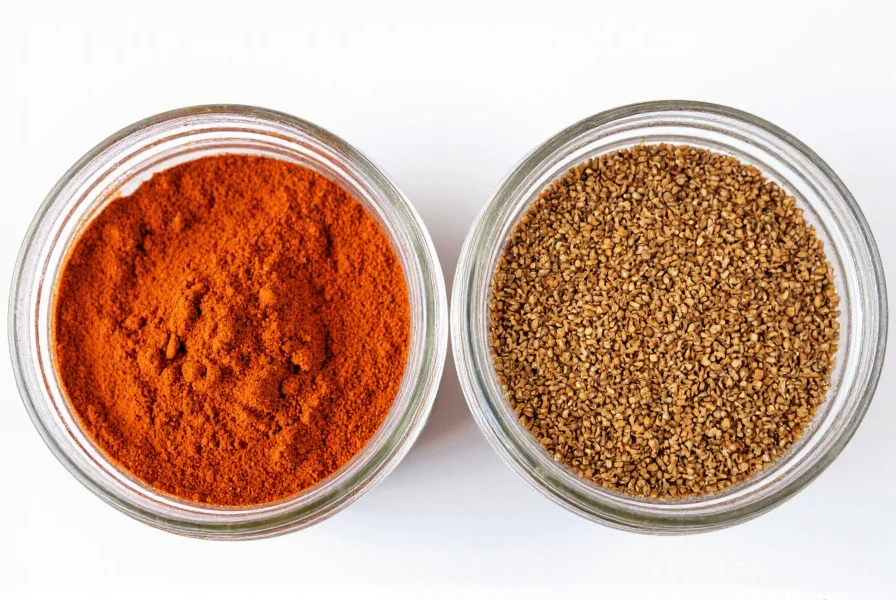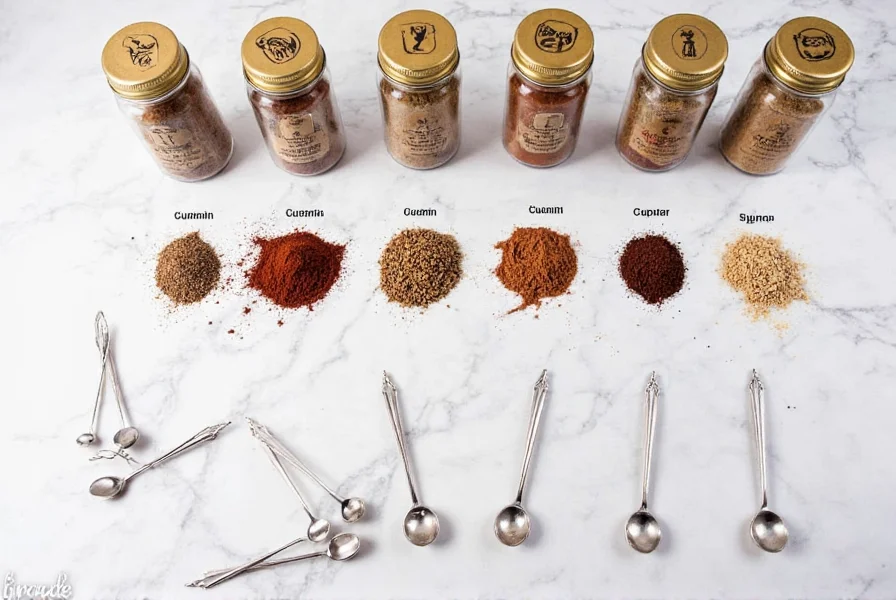If you're reaching for cumin mid-recipe only to find your spice jar empty, don't panic. Several common pantry staples can effectively replace cumin while maintaining your dish's integrity. The right substitute depends on your recipe type, desired flavor profile, and what's available in your kitchen. Understanding these alternatives prevents recipe disasters and expands your culinary flexibility.
Why You Might Need a Cumin Substitute
Cumin's distinctive earthy, warm, and slightly citrusy flavor appears in global cuisines from Mexican to Indian to Middle Eastern. You might need alternatives due to pantry shortages, dietary restrictions, flavor fatigue, or simply wanting to experiment. Unlike some spices, cumin has no perfect 1:1 replacement, but strategic swaps preserve your dish's character while introducing interesting variations.
Top 5 Cumin Substitutes Ranked by Effectiveness
1. Chili Powder (Best for Mexican Dishes)
Chili powder contains cumin as a primary ingredient along with garlic, oregano, and paprika. This makes it an excellent emergency substitute, especially in chili, tacos, and enchiladas. Use equal parts chili powder to replace cumin. The blend provides similar earthiness with added complexity. Pro tip: For authentic chili recipes, combine chili powder with a pinch of oregano to mimic cumin's distinctive notes.

2. Coriander (Best for Indian Cooking)
Coriander offers a citrusy, floral profile that complements cumin's earthiness in Indian and Middle Eastern dishes. Use 1.5 parts coriander for every 1 part cumin since it's milder. This pairing actually mirrors how many traditional recipes use both spices together. When substituting in curries or rice dishes, add a pinch of smoked paprika to approximate cumin's depth.
3. Taco Seasoning (Best Quick Fix)
Most commercial taco seasonings contain cumin as a key ingredient. Use a 1:1 ratio when replacing cumin in Mexican dishes. Check the ingredients first—quality blends contain 25-30% cumin. For homemade taco seasoning replacement, combine 2 parts paprika, 1 part garlic powder, and 1 part onion powder.
4. Garam Masala (Best for Complex Flavors)
This Indian spice blend typically contains cumin plus cardamom, cloves, and cinnamon. Use half the amount of garam masala compared to cumin since it's more potent. It works particularly well in lentil dishes and vegetable stews where you want layered flavors. Avoid using in recipes requiring cumin's distinctive solo presence like chili.
5. Paprika (Best Mild Alternative)
Smoked paprika provides earthiness without cumin's citrus notes. Use a 1:1 ratio in bean dishes, rubs, or soups where you want warmth without dominating the flavor profile. For recipes requiring cumin's distinctive bite, add a pinch of cayenne to paprika. This substitute works best when cumin plays a supporting rather than starring role.
| Substitute | Ratio | Best For | Flavor Difference |
|---|---|---|---|
| Chili Powder | 1:1 | Mexican dishes, chili | Slightly sweeter, more complex |
| Coriander | 1.5:1 | Indian curries, rice | More citrusy, less earthy |
| Taco Seasoning | 1:1 | Tacos, fajitas | More herbal notes |
| Garam Masala | 0.5:1 | Lentil dishes, stews | Warmer, spicier profile |
| Smoked Paprika | 1:1 | Bean dishes, rubs | Milder, less distinctive |
Special Considerations for Specific Dishes
For chili recipes: Combine equal parts chili powder and paprika. This mimics cumin's earthiness while maintaining the dish's characteristic warmth. Many professional chefs actually prefer this blend over pure cumin for deeper flavor complexity.
For Indian cooking: Create a custom blend using 2 parts coriander, 1 part turmeric, and 0.5 parts cayenne. This approximation works particularly well in dal and vegetable curries where cumin typically plays a supporting role.
For meat rubs: Use equal parts smoked paprika and garlic powder. The smokiness compensates for cumin's absence while garlic enhances savory notes. Add a teaspoon of cocoa powder for steak rubs to replicate cumin's earthy depth.
Creative Flavor Variations Using Substitutes
Instead of viewing substitutes as compromises, consider them opportunities to innovate. When making hummus, replace cumin with equal parts coriander and a pinch of cardamom for a Middle Eastern twist. In black bean soup, use chipotle powder instead of cumin for smoky heat that complements the beans' earthiness.
For those avoiding cumin due to allergies or sensitivities, fenugreek offers a similar earthy profile at a 0.75:1 ratio. Toast the fenugreek seeds lightly before grinding to enhance their nutty characteristics. This works particularly well in vegetarian dishes where cumin typically provides depth.
When Substitutes Won't Work
Some dishes rely so heavily on cumin's distinctive flavor that substitutes fundamentally change the character. Traditional Yemeni hawaij spice blend and certain Moroccan tagines require authentic cumin. In these cases, consider modifying the recipe rather than substituting—reduce other spices slightly to compensate for cumin's absence, or add complementary flavors like toasted sesame seeds that provide earthiness through different means.
Storing and Maximizing Substitute Spices
Keep your substitute spices fresh by storing them in airtight containers away from light and heat. Whole spices maintain potency longer than ground—consider keeping coriander seeds and toasting them as needed for maximum flavor when substituting for cumin. For frequent cumin users, keep a small emergency stash in the freezer where spices retain freshness for up to three years.

Final Recommendations
The ideal cumin substitute depends on your specific recipe and flavor goals. For most home cooking emergencies, chili powder provides the closest approximation with minimal adjustment. When crafting authentic regional dishes, tailor your substitute to the cuisine—coriander for Indian recipes, taco seasoning for Mexican dishes. Remember that successful substitution isn't about perfect replication but maintaining your dish's essential character while working with available ingredients.
Frequently Asked Questions
What's the best cumin substitute for chili recipes?
Chili powder makes the best cumin substitute for chili recipes. Use equal parts chili powder to replace cumin, as most blends contain cumin as a primary ingredient along with complementary spices like garlic and oregano. For enhanced flavor, combine chili powder with a pinch of smoked paprika.
Can I use coriander instead of cumin in Indian cooking?
Yes, coriander works well as a cumin substitute in Indian cooking but requires adjustment. Use 1.5 parts coriander for every 1 part cumin since it's milder. For better approximation of cumin's earthiness, add a pinch of smoked paprika to your coriander substitution.
What's a good cumin replacement for people with spice allergies?
For those with cumin allergies, toasted sesame seeds provide earthiness without allergens. Use 1 tablespoon toasted sesame seeds (ground) to replace 1 teaspoon cumin. Fenugreek also works at a 0.75:1 ratio, but check with your allergist first as some people react to multiple spices.
How much taco seasoning equals one teaspoon of cumin?
Use 1 teaspoon of taco seasoning to replace 1 teaspoon of cumin. Most quality taco seasonings contain approximately 25-30% cumin along with complementary spices. Check the ingredients list first—higher quality blends work better for direct substitution.
Does paprika work as a cumin substitute in all recipes?
Paprika works as a cumin substitute only in specific applications. Use smoked paprika at a 1:1 ratio in bean dishes, rubs, or soups where cumin plays a supporting role. It won't work in recipes where cumin is the dominant flavor, like traditional chili or certain Middle Eastern dishes, as it lacks cumin's distinctive citrus notes.











 浙公网安备
33010002000092号
浙公网安备
33010002000092号 浙B2-20120091-4
浙B2-20120091-4